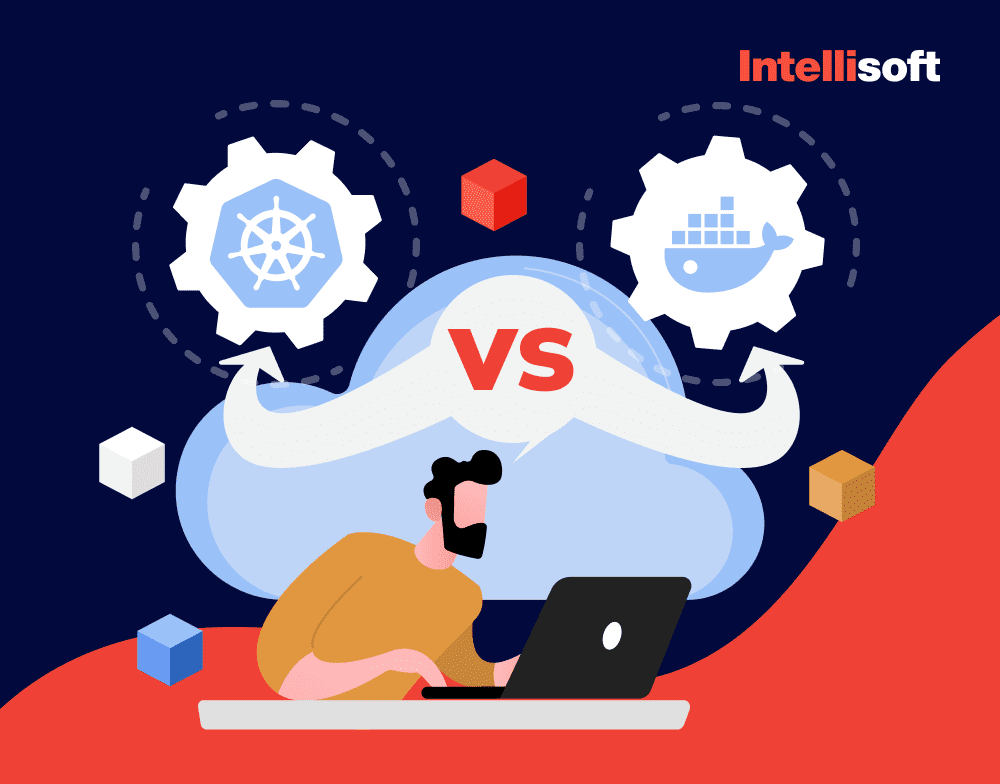CodeIgniter vs Laravel stand out as paragons of innovation and efficiency in web development.
What Is Laravel? It is the leading framework that fuels an impressive 704,255 websites, commanding a notable 3.79% market share among the top 10,000 websites. Not far behind, CodeIgniter powers 487,713 websites, securing a 1.47% share in the same elite category. These statistics highlight the significant influence and widespread adoption of both frameworks, underscoring their prominence in the web development landscape.
Laravel vs CodeIgniter has revolutionized the creation of custom web applications, providing developers with structured and intuitive environments. Their ability to streamline and enhance the development process is truly exceptional.
Join us as we delve into each framework’s core strengths and unique features, revealing the secrets behind their enduring popularity. Prepare for an insightful journey through CodeIgniter vs Laravel as we compare these giants of contemporary web development.
Table of Contents
Market Usage Statistics – Laravel vs. CodeIgniter
Some recent statistics can help you better understand how Laravel vs CodeIgniter are different.
CodeIgniter
- Currently, 42% of the web framework market is dominated by CodeIgniter.
- On GitHub, it has received 2k ratings and 7.7k forks.
- CodeIgniter has created 519,417 websites in 39 countries, including Japan, India, Vietnam, Indonesia, and others.
Laravel
- Among all of the existing web frameworks, Laravel commands a market share of 16%.
- With 26.3k active projects, Laravel currently has 1k Github stars and is a real-time framework.
- Approximately 304,414 websites in the US area apply Laravel as the preferred PHP framework.
What Is CodeIgniter?
CodeIgniter has pre-built database connectivity libraries. The standard set of libraries provides all the essential functions that a developer most often requires (e.g., sending emails or processing visual elements).
The framework functions on the MVC model. The CodeIgniter architecture combines flexibility and programmer freedom.
CodeIgniter offers a wide range of features for various operations, such as database connectivity, flexible URL redirection, session management, caching, zip coding, application profiling, and data encryption.
Features of Codelgniter
What is CodeIgniter used for? Here are the main features of CodeIgniter.
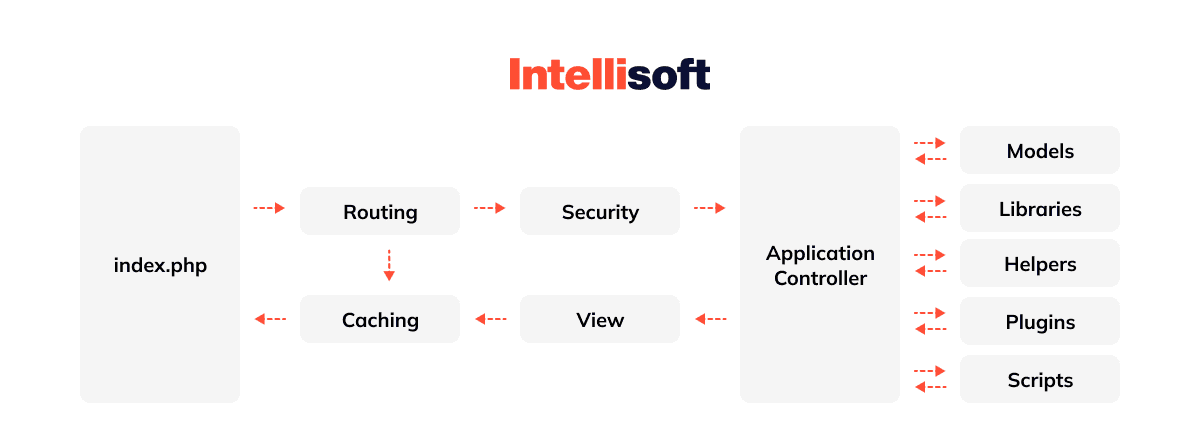
- Speedy development
CodeIgniter is the fastest web development framework. This framework can help you build websites rapidly.
CodeIgniter is an excellent solution for individuals seeking better website functionality with less coding. - Enhanced security
Security against CSRF and XSS threats is also built-in. Thus, it makes it easy for developers to write safe PHP applications, which is very important for all developers. It protects your website from security risks like SQL injection, cross-site scripting attacks, and remote code execution. - The MVC-based system
Because MVC is compatible with Test-Driven Development, developers may create and test modules with pinpoint accuracy in response to specifications.
Core libraries for the system are easier to create when they can integrate with pre-existing scripts. MVC pattern is the core principle of CodeIgniter. Thanks to its Model-View-Controller (MVC) design, CodeIgniter development makes creating and managing complex applications simple. - Perfect bug detection and removal
Developers use CodeIgniter to build bug-free, high-quality websites. CodeIgniter has an intuitive interface, which helps find website faults and bugs, improving user experience. Code mistakes are apparent when using this framework. - Better search engine optimization
CodeIgniter’s capacity to enhance search engine optimization (SEO) ranking is another reason why it is ideally suited for website development. To boost website traffic, digital marketing specialists highly recommend this platform.
In addition, the platform offers many tools that improve SEO without impacting the design or functionality of the website. - Community support
It has a user community that is flourishing and growing all the time. When you have a question or problem, you may turn to the vast community in the CodeIgniter forums, which has a membership of over 57,000 people and is still expanding. Not only smart wiki and FAQ sections might be useful, but a helping hand from other developers and engineers. - Customizability
The website’s creators may always change it to match future requirements, saving them time. Compared to the other available frameworks on the market, PHP CodeIgniter is the only one, according to the opinions of several industry professionals, that modifies a breeze.
When searching for a possible custom website creation service, depending on CodeIgniter is recommended for a number of reasons, the most important of which are quick error correction and more straightforward file configuration. - User-friendly interface
The CodeIgniter framework is easy to use and light. Its features are simple to modify to suit your needs. Additionally accessible with CodeIgniter development are database abstraction layers. With CodeIgniter, changing the database is easy, including adding and removing columns and adding and deleting existing ones from tables. - Hassle-free migration
Developers can move quickly from one server to another with CodeIgniter. You can quickly move old data from wherever to this site. And if you have any problems while moving, you can always count on the support of its large and helpful community. - Test-driven development
CodeIgniter is the only framework that fully supports test-driven development, a methodology that allows web designers and developers to test their work at each stage of the process. This opportunity enables designers to assess the site’s functionality and performance swiftly. Using a systematic approach, they can quickly verify each stage of development and finish testing.
Who Uses Codelgniter?
Most CodeIgniter 4 users are in the United States and the Information Technology and Services sector. Businesses frequently use CodeIgniter with 1 to 10 employees and $1 million to $10 million in annual revenue.
- The Mail & Guardian
- McClatchy
- Nissan
- Search Engine Optimization, Inc.
- Buffer
- NetSuite Inc
- California State University
- NetSuite Inc
- Casio Computers
- Freedcamp
Benefits of Codelgniter
From the ease of migration to a friendly community, many benefits of CodeIgniter attract developers.
- On-the-spot configuration
The installation of CodeIgniter and the creation of your initial program are both simple tasks. This web framework also comes with an easy-to-follow handbook you may use if you find yourself in a bind. - Simple migration
Despite the enormous data, users can seamlessly migrate from one server to another. This fact makes CodeIgniter the favored option for resolving the technical issues developers typically encounter during migration. - Rather lightweight
CodeIgniter won’t take up much of your storage space because the download is only 1.1 megabytes, and the user guide (in epub format) is 1.6 megabytes. - Test-driven development
Regardless of how CodeIgniter doesn’t have testing usefulness as standard, it incorporates various outsider libraries that might be utilized to test your code as you compose it. - Website customizability
Because CodeIgniter does not adhere precisely to the MVC design, developers can personalize the web applications they create according to their preferences. - Has multiple libraries for picture manipulations
Because it supports GD, NetPBM, and Image Magick for image resizing, cropping, and rotation, this framework is ideal for visually-rich web applications. - Extended community
Many of the source codes used to improve website creation have been contributed to by the enthusiastic and helpful community of supporters. CodeIgniter has better organization and more comprehensive documentation than competing frameworks. - Inbuilt class to send emails
Because of this functionality, utilizing CodeIgniter makes sending email messages to recipients simple.
Cons of Codelgniter
Even though CodeIgniter is a popular lightweight web framework, it has some pitfalls to consider.
- Lack of full-scale libraries
In contrast to the PHP frameworks of the modern day, this one includes a comprehensive list of libraries, which may cause it to fall behind its competitors. - Unstable code maintainability
Updating, modifying, and maintaining the code is laborious for developers and consumes significant time. - Passive growth
The slowdown in development and growth, along with fewer updates, has led to incompatible versions.
What Is Laravel?
Laravel is a popular PHP framework that you can download for free. It has everything a PHP developer needs to make a website, including all the required components and functionalities.
Laravel prioritizes Elegance, Simplicity, and Readability, and it is the best PHP framework available for creating apps. Laravel is open-source. Therefore its Github repository contains the source code.
Features of Laravel
The framework included in it has a comprehensive ecosystem that provides for instant deployment, routing, templating, object relationship modeling (ORM), database querying, and listing.
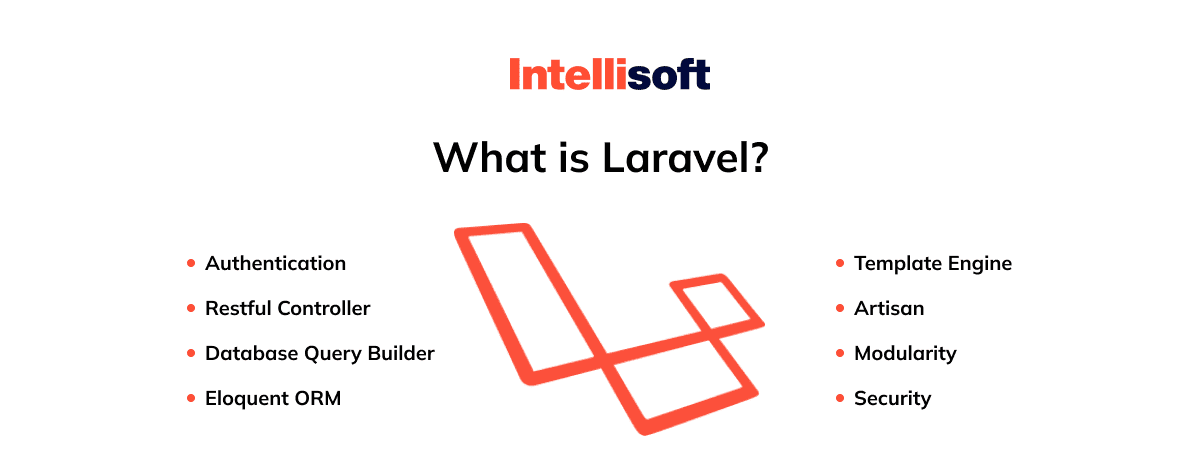
- Effective ORM
Laravel has a PHP Active Record ORM. A good ORM lets developers query database tables using PHP syntax without SQL code. By assigning models to database tables, it simplifies developer integration. - MVC Maintenance
Laravel supports MVC architecture. It offers multiple views for a model and avoids code duplication by separating the display and business logic. As with MVC, it provides a quicker development process; one programmer may work on the view while another is working on the controller to design the web application’s business logic. - Authentication
Every website owner is responsible for preventing unauthorized users from gaining access to any of the website’s paid or restricted features. It’s a straightforward solution for authentication. It’s also a specific method of managing access permissions and authorizing new users. - Innovative Template Engine
A unique template engine is made available by Laravel, which makes it possible for developers to design dynamic websites. An application’s framework may be given a firm foundation by utilizing the widgets available in Laravel. - Intact Safety
One of the most crucial aspects of web application development is application security. While fostering an application, a software engineer must take powerful methods for getting the application. Laravel has built-in web application security, which means that it handles application security on its own. It is possible to generate the salted password using the “Bcrypt Hashing Algorithm,” which indicates that the password is saved in a database as an encrypted password rather than plain text. - Secure Migration System
The database may be expanded using the Laravel framework without the developers putting in much effort each time they make changes. In addition, the migration method used by Laravel is incredibly safe and foolproof. Instead of SQL, PHP code is utilized throughout the procedure. - Original Unit-Testing
Laravel has a unique unit-testing feature. The Laravel framework allows several test cases to see if the modifications break the online application. Developers can write test cases for Laravel themselves. - Libraries & Modular
Object-oriented libraries and pre-installed libraries make Laravel popular. A popular authentication library offers password reset, active user monitoring, Bcrypt hashing, and CSRF protection. This framework lets developers construct responsive, modular applications with PHP modules.
Who Uses Laravel?
What is Laravel used for? Companies in the United States and the Information Technology and Services sector are the most common places to find Laravel in use. The sweet spot for Laravel usage is between one and ten employees and one and ten million dollars in annual sales.
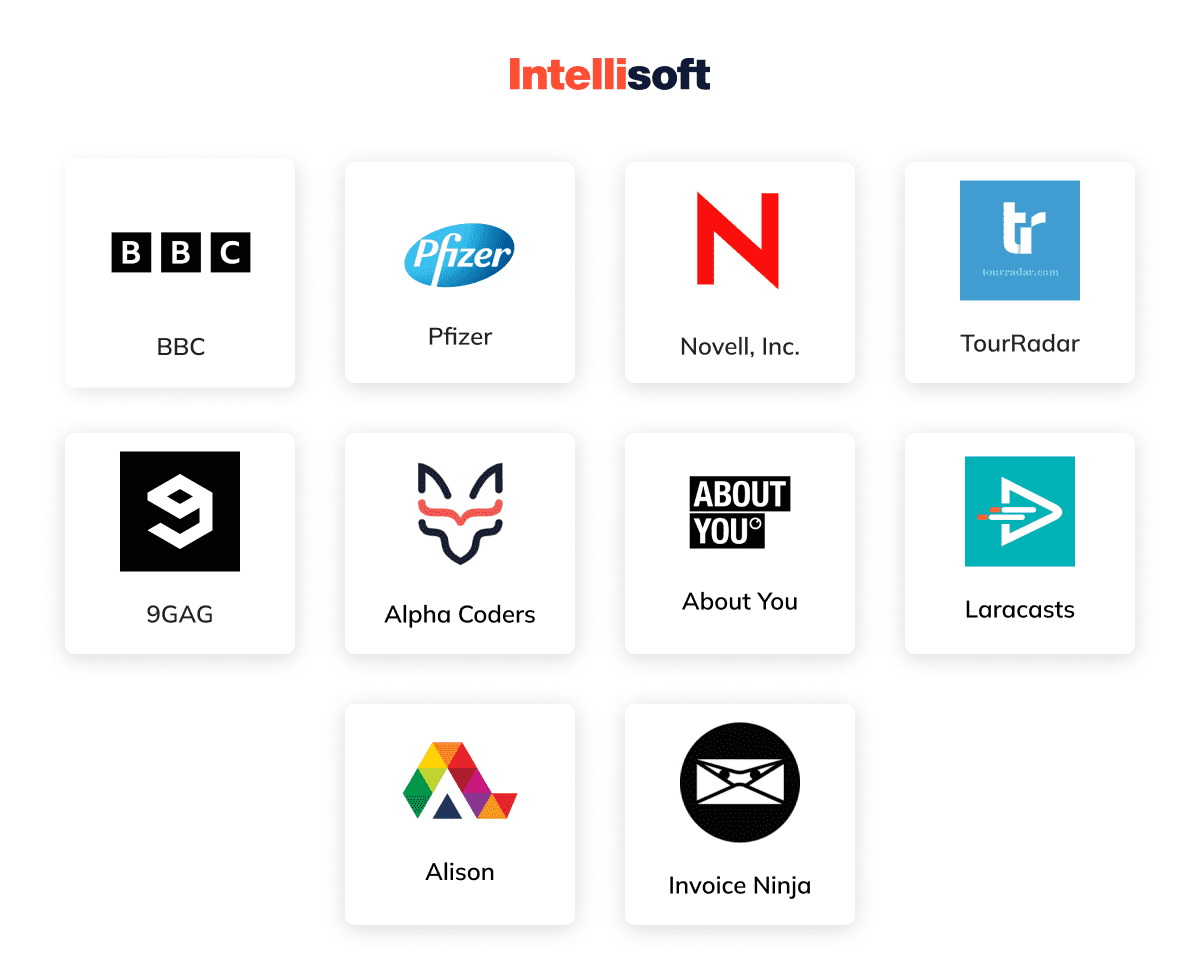
Benefits of Laravel
One of the most powerful open-source PHP solutions is the Laravel. It is straightforward for developers to design expansive, secure, dynamic websites because of their user-friendly URLs. Let’s explore other benefits of using Laravel.
- Inbuilt authentication
When utilizing a web application made with framework Laravel, users may register, log in, and even retrieve passwords, thanks to the built-in authentication functionality. - Configuration management system
Sometimes, the apps need to function in various settings. Laravel offers a streamlined and consistent method for handling such setups. - Extended testing suite
A testing suite allows for more efficient and automated testing. Laravel provides expressive testing techniques through PHPUnit, which mimic user behavior by sending requests to the application’s functionalities. Testing is simplified and streamlined due to this automation, which saves time. - Defined routing
With reverse routing, route modifications are automatically broadcast to all connected nodes. It generates URIs, or Uniform Resource Identifiers, on its own. - Modularity
When utilizing Laravel, developers may divide their code into manageable chunks. When developers wish to update various components of the code base, Composer dependency management is also useful. - Autoloading feature
Laravel enables the automation of any form of repetitive, application-specific tasks. It provides contemporary boilerplate programs to handle databases and migrations and quickly build custom tasks. - Pre-packaged instruments
These make it easier to do routine chores necessary for developing web applications by providing ready-to-use packages for user authentication and testing APIs.
Related readings:
- PostgreSQL vs MySQL: Major Similarities and Differences between Them
- RabbitMQ vs Kafka: Choosing the Right Messaging System for Your Needs
- Typescript vs Javascript: Which Programming Language Fits Your Project?
- Node JS Advantages and Use Cases: Is This Environment Right for You?
- Key Trends Shaping Digital Transformation You Shouldn’t Miss in 2022-2023
Pitfalls of Laravel
Laravel could be better, just like CodeIgniter. So, apart from the benefits of Laravel, what are its drawbacks?
- Library quality
While Laravel may be open-sourced and supported by a large community, it also results in a rise of third-party libraries that are less dependable. - Lightweight
The lightweight aspect of this framework is usually a plus. But it causes excessive backend database query congestion, resulting in inferior performance and data congestion. - Community
The size of the Laravel community means that many third-party libraries have been developed and released. Determining which library can be trusted and has met quality standards gets increasingly challenging.
What Makes the Difference Between Codelgniter and Laravel?
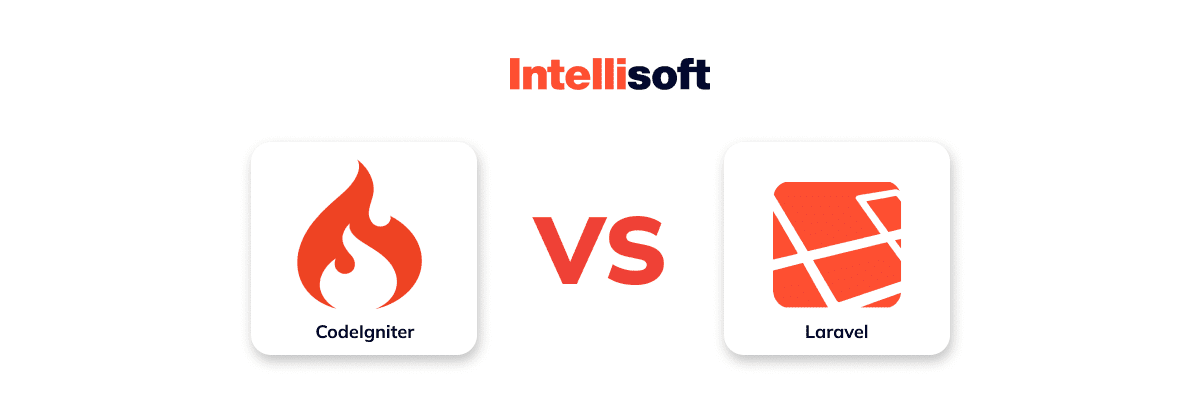
Codeigniter is an Object-Oriented framework, while Laravel is an Object-Relational Framework. Unlike Laravel, which includes authentication classes out of the box, Codeigniter does not. Check more differences between Laravel 9 vs CodeIgniter 4 in our table.

Laravel vs CodeIgniter Performance
When comparing Laravel vs CodeIgniter performance, it’s essential to consider various factors. Here’s an overview of the performance aspects of these PHP frameworks:
CodeIgniter Performance
- CodeIgniter is known for its lightweight and speed. It has a small footprint is optimized for quick development, making it an excellent choice for small to medium-sized projects.
- CodeIgniter 4 is the latest version designed to work with PHP 7 and later, contributing to its performance improvements.
- It offers excellent performance when handling simple web applications due to its minimalistic design and faster load times.
Laravel Performance
- Laravel is a feature-rich framework with more extensive capabilities, which can affect performance depending on the project’s complexity.
- It is known for its elegant syntax and developer-friendly features, but this can introduce some overhead.
- Laravel optimizes performance through caching, database query optimization, and other features. It is suitable for small and large projects but may require more server resources for complex applications.
When comparing CodeIgniter 4 vs Laravel, CodeIgniter is favored for its speed and simplicity, making it an excellent choice for smaller projects. Laravel, on the other hand, offers more features and scalability but may require additional server resources for complex applications.
Which Web Framework to Use: CodeIgniter or Laravel?
CodeIgniter vs Laravel, which is better? The two web frameworks are equally well-known. CodeIgniter and Laravel are two outstanding PHP frameworks with advantages and disadvantages. The needs of your company and the nature of your web project will determine which of these two frameworks you should use.
CodeIgniter is a great option when:
- Speed is a primary concern. It is significantly faster than Laravel both in terms of execution and development.
- Creating e-commerce websites.
- Basic, expandable sites are a goal.
You need a simple framework without any integrated testing or database management capabilities.
Laravel is a better option for you if:
- Laravel is a familiar concept to your team.
- You are looking for a full-stack framework that can accommodate the entirety of the web or mobile app development lifecycle.
- You need to handle complicated, multi-featured websites of any size.
Official documentation for both is extensive and informative. However, IntelliSoft is where you may find further assistance.
IntelliSoft is home to a team of expert programmers, engineers, project managers, and consultants. We can assemble a special team to handle your project, whether you need CodeIgniter or Laravel developers. Contact us and tell us about tech challenges you are currently struggling with, so that we can help you.










